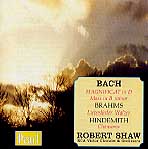No question, this release featuring recordings made between 1945 and 1947 will be of interest to fans of the eminent choral conductor Robert Shaw, but it also offers an unusual closeup look at what a first-rate American choir considered to be stylistic correctness back then. As for Shaw’s imprint on this varied program, the one thing you notice above all else–in spite of the constricted, nearly airless sound–is the clarity and detail he achieves among the vocal lines and between instruments and voices. No matter that the vibrato is free and rampant, and there may be just a few too many American dipthongs flying around in the Latin text of Bach’s Magnificat, nevertheless the articulation is conscientious and the ensemble precision anything but accidental.
Although much is made in the notes regarding the decision to include two excerpts from Bach’s B minor mass–the fact of rare appearances by violinist Oscar Shumsky–the sound is atrocious and tenor Lucius Metz’s Latin is unforgivably mangled in the “Benedictus”. Far better are the very coffee-house-ish (or is it beer-hall-like?) performances of the Liebeslieder Walzer Op. 52, which are sung with a true feel for the style of these light and lovely songs. It’s interesting to compare these with Shaw’s recording nearly 50 years later (in 1992) with his Festival Singers (Telarc). Other than the markedly improved sound(!) the new interpretations are surprisingly similar to the old ones in their easy tempos, smoothly flowing lines, and of course, clean, clear articulation and careful balances.
The generous program (nearly 67 minutes) ends with Hindemith’s Six Chansons, which at the time of the recording (1945) were truly contemporary works, having been composed only six years before. Shaw and his singers obviously loved these pieces and really had a grasp of their edgy, angular harmonic style–and I only wish that the sound were better, as for me this set proved the highlight of this never-less-than-interesting trip into history.
































